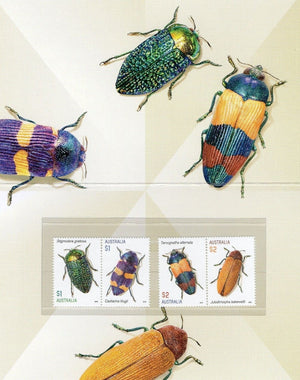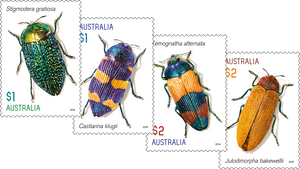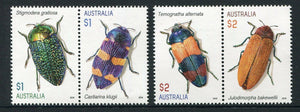Your Cart is Empty



2016 Jewel Beetles Mint Unhinged Stamps
Just over 1,280 (of around 15,000) Buprestidae species are found in Australia, spanning more than 80 genera. They are commonly known as “jewel beetles”, due to their spectacular and iridescent appearance. Their colour changes depending on the angle of the light and doesn’t fade, which is how jewel beetles retain their jewel-like sparkle, even after they die.
During the warmer months they are often seen on the flowers of native trees and shrubs, in various forests, woodlands and desert environments throughout Australia. Most adult jewel beetles are nectar feeders, drinking from tea-tree and eucalyptus flowers, but some are leaf feeders.
Jewel beetles are relatively small. Though many jewel beetles are under 20 millimetres, they can range in size from three to 80 millimetres. They have an elongated body shape, large eyes, short antennae and a short head, which fits tightly into their thorax. Some jewel beetles, when disturbed or feeling threatened, will tuck their antennae and legs into their body and drop to the ground, as a defence mechanism.
There are four bright and colourful Australian jewel beetle species featured in this stamp issue:Stigmodera gratiosa (from Western Australia), Castiarina klugii (found in NSW and parts of Victoria), Temognatha alternata (found on the north-east coast of Queensland) and Julodimorpha bakewellii (found within New South Wales, South Australia, Victoria and Western Australia). The life-like illustrations, by Owen Bell, were based on jewel beetle specimens found within the natural history collection of Museum Victoria.